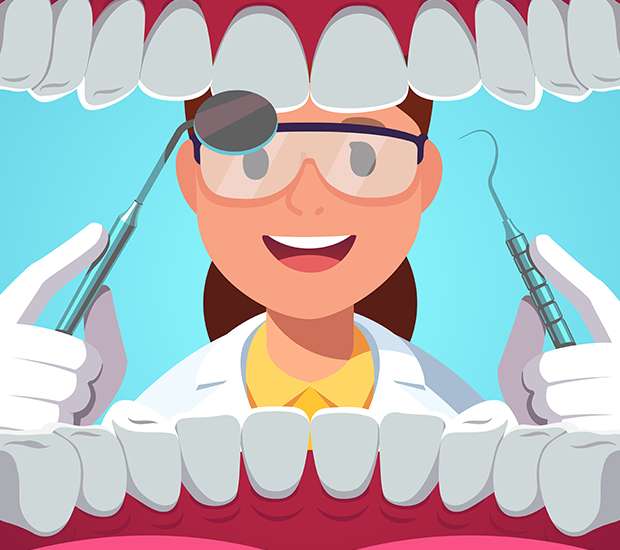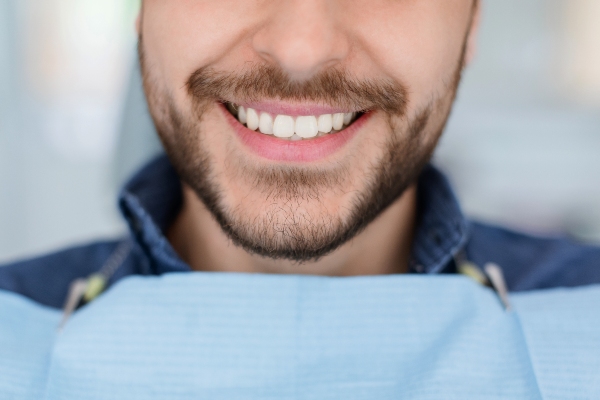FAQsMiddletown, NY
Below are some of the most frequently asked questions patients have about dentistry and oral health issues. If you have any other questions, or would like to schedule an appointment, we would love to hear from you.
How often should I brush and floss?
Brushing and flossing help control the plaque and bacteria that cause dental disease.
Plaque is a film of food debris, bacteria, and saliva that sticks to the teeth and gums. The bacteria in plaque convert certain food particles into acids that cause tooth decay. Also, if plaque is not removed, it turns into calculus (tartar). If plaque and calculus are not removed, they begin to destroy the gums and bone, causing periodontal (gum) disease.
Plaque formation and growth is continuous and can only be controlled by regular brushing, flossing, and the use of other dental aids.
Toothbrushing – Brush your teeth at least twice a day (especially before going to bed at night) with an ADA approved soft bristle brush and toothpaste.
• Brush at a 45 degree angle to the gums, gently using a small, circular motion, ensuring that you always feel the bristles on the gums.
• Brush the outer, inner, and biting surfaces of each tooth.
• Use the tip of the brush head to clean the inside front teeth.
• Brush your tongue to remove bacteria and freshen your breath.
Electric toothbrushes are also recommended. They are easy to use and can remove plaque efficiently. Simply place the bristles of the electric brush on your gums and teeth and allow the brush to do its job, several teeth at a time.
Flossing – Daily flossing is the best way to clean between the teeth and under the gumline. Flossing not only helps clean these spaces, it disrupts plaque colonies from building up, preventing damage to the gums, teeth, and bone.
• Take 12-16 inches (30-40cm) of dental floss and wrap it around your middle fingers, leaving about 2 inches (5cm) of floss between the hands.
• Using your thumbs and forefingers to guide the floss, gently insert the floss between teeth using a sawing motion.
• Curve the floss into a “C” shape around each tooth and under the gumline. Gently move the floss up and down, cleaning the side of each tooth.
Floss holders are recommended if you have difficulty using conventional floss.
Rinsing – It is important to rinse your mouth with water after brushing, and also after meals if you are unable to brush. If you are using an over-the-counter product for rinsing, it’s a good idea to consult with your dentist or dental hygienist on its appropriateness for you.
How often should I have a dental exam and cleaning?
You should have your teeth checked and cleaned at least twice a year, though your dentist or dental hygienist may recommend more frequent visits.
Regular dental exams and cleaning visits are essential in preventing dental problems and maintaining the health of your teeth and gums. At these visits, your teeth are cleaned and checked for cavities. Additionally, there are many other things that are checked and monitored to help detect, prevent, and maintain your dental health. These include:
• Medical history review: Knowing the status of any current medical conditions, new medications, and illnesses, gives us insight to your overall health and also your dental health.
• Examination of diagnostic x-rays (radiographs): Essential for detection of decay, tumors, cysts, and bone loss. X-rays also help determine tooth and root positions.
• Oral cancer screening: Check the face, neck, lips, tongue, throat, tissues, and gums for any signs of oral cancer.
• Gum disease evaluation: Check the gums and bone around the teeth for any signs of periodontal disease.
• Examination of tooth decay: All tooth surfaces will be checked for decay with special dental instruments.
• Examination of existing restorations: Check current fillings, crowns, etc.
• Removal of calculus (tartar): Calculus is hardened plaque that has been left on the tooth for sometime and is now firmly attached to the tooth surface. Calculus forms above and below the gum line, and can only be removed with special dental instruments.
• Removal of plaque: Plaque is a sticky, almost invisible film that forms on the teeth. It is a growing colony of living bacteria, food debris, and saliva. The bacteria produce toxins (poisons) that inflame the gums. This inflammation is the start of periodontal disease!
• Teeth polishing: Removes stain and plaque that is not otherwise removed during toothbrushing and scaling.
• Oral hygiene recommendations: Review and recommend oral hygiene aids as needed (electric dental toothbrushes, special cleaning aids, fluorides, rinses, etc.).
• Review dietary habits: Your eating habits play a very important role in your dental health.
As you can see, a good dental exam and cleaning involves quite a lot more than just checking for cavities and polishing your teeth. We are committed to providing you with the best possible care, and to do so will require regular check-ups and cleanings.
Why is it important to use dental floss?
Brushing our teeth removes food particles, plaque, and bacteria from all tooth surfaces, except in between the teeth. Unfortunately, our toothbrush can’t reach these areas that are highly susceptible to decay and periodontal (gum) disease.
Daily flossing is the best way to clean between the teeth and under the gumline. Flossing not only helps clean these spaces, it disrupts plaque colonies from building up, preventing damage to the gums, teeth, and bone.
Plaque is a sticky, almost invisible film that forms on the teeth. It is a growing colony of living bacteria, food debris, and saliva. The bacteria produce toxins (acids) that cause cavities and irritate and inflame the gums. Also, when plaque is not removed above and below the gumline, it hardens and turns into calculus (tartar). This will further irritate and inflame the gums and also slowly destroy the bone. This is the beginning of periodontal disease.
How to floss properly:
• Take 12-16 inches (30-40cm) of dental floss and wrap it around your middle fingers, leaving about 2 inches (5cm) of floss between the hands.
• Using your thumbs and forefingers to guide the floss, gently insert the floss between teeth using a sawing motion.
• Curve the floss into a “C” shape around each tooth and under the gumline. Gently move the floss up and down, cleaning the side of each tooth.
Floss holders are recommended if you have difficulty using conventional floss.
Daily flossing will help you keep a healthy, beautiful smile for life!
When are sealants recommended?
Although thorough brushing and flossing remove most food particles and bacteria from easy to reach tooth surfaces, they do not reach the deep grooves on chewing surfaces of teeth. More than 75 percent of dental decay begins in these deep grooves (called pits and fissures). Toothbrush bristles are too large to possibly fit and clean most of these areas. This is where sealants play an important role.
A sealant is a thin plastic coating that covers and protects the chewing surfaces of molars, premolars, and any deep grooves or pits on teeth. Sealant material forms a protective, smooth barrier covering natural depressions and grooves in the teeth, making it much easier to clean and help keep these areas free of decay.
Who may need sealants?
• Children and teenagers - As soon as the six-year molars (the first permanent back teeth) appear or any time throughout the cavity prone years of 6-16.
• Infants - Baby teeth are occasionally sealed if the teeth have deep grooves and the child is cavity prone.
• Adults - Tooth surfaces without decay that have deep grooves or depressions that are difficult to clean.
Sealants are easily applied by your dentist or dental hygienist and the process only takes minutes per tooth. After the chewing surfaces are roughened with an acid solution that helps the sealant adhere to the tooth, the sealant material is “painted” onto the tooth surface, where it hardens and bonds to the teeth. Sometimes a special light will be used to help the sealant material harden.
After sealant treatment, it’s important to avoid chewing on ice cubes, hard candy, popcorn kernels, or any hard or sticky foods. Your sealants will be checked for wear and chipping at your regular dental check-up.
Combined with good home care, a proper diet, and regular dental check-ups, sealants are very effective in helping prevent tooth decay.
What should I do if a tooth is knocked out?
We’re all at risk for having a tooth knocked out. More than 5 million teeth are knocked out every year! If we know how to handle this emergency situation, we may be able to actually save the tooth. Teeth that are knocked out may be possibly reimplanted if we act quickly, yet calmly, and follow these simple steps:
1. Locate the tooth and handle it only by the crown (chewing part of the tooth), NOT by the roots.
2. DO NOT scrub or use soap or chemicals to clean the tooth. If it has dirt or debris on it, rinse it gently with your own saliva or whole milk. If that is not possible, rinse it very gently with water.
3. Get to a dentist within 30 minutes. The longer you wait, the less chance there is for successful reimplantation.
Ways to transport the tooth
• Try to replace the tooth back in its socket immediately. Gently bite down on gauze, a wet tea bag or on your own teeth to keep the tooth in place. Apply a cold compress to the mouth for pain and swelling as needed.
• If the tooth cannot be placed back into the socket, place the tooth in a container and cover with a small amount of your saliva or whole milk. You can also place the tooth under your tongue or between your lower lip and gums. Keep the tooth moist at all times. Do not transport the tooth in a tissue or cloth.
• Consider buying a “Save-A-Tooth” storage container and keeping it as part of your home first aid kit. The kit is available in many pharmacies and contains a travel case and fluid solution for easy tooth transport.
The sooner the tooth is replaced back into the socket, the greater the likelihood it has to survive and possibly last for many years. So be prepared, and remember these simple steps for saving a knocked-out tooth.
You can prevent broken or knocked-out teeth by:
• Wearing a mouthguard when playing sport.
• Always wearing your seatbelt
• Avoiding fights
• Avoid chewing hard items such as ice, popcorn kernels, hard breads, etc.
Why straighten teeth?
Straighter teeth perform chewing, biting, and speaking functions more effectively than crooked teeth. In addition, a straight smile boosts confidence, is aesthetically pleasing to look at, and can help stave off a wide variety of dental ailments.
There are several types of malocclusion including overbite, underbite, crossbite, and overcrowding. Each of these alignment problems negatively impacts the functionality and cosmetic appearance of the teeth.
Here is a brief overview of some of the main disorders associated with crooked teeth:
• Periodontitis – Periodontitis or gum disease begins with a bacterial infection. The bacterial infection is caused by inadequate oral hygiene. Crooked teeth are hard to effectively clean, which means that debris, plaque, and bacteria can build up in hard-to-reach areas. Straight teeth are much easier to clean and are at less risk of contracting gum disease.
• Temporomandibular Disorder (TMJ) - Crooked teeth can lead to improper jaw alignment, which in turn causes a painful condition known as TMJ. Severe headaches, jaw pain, lockjaw, and grinding of teeth characterize this debilitating disorder.
• Tooth injury – Straight teeth create a strong wall, which means injuries are less likely to occur. Crooked teeth are weaker and often protrude, making them far more vulnerable to external injury.
• Uneven wear – Crooked teeth cause some of the teeth to work harder than others when biting and chewing. Straight teeth share the workload evenly, meaning less risk of injury and better aesthetics.
Teeth can be straightened using either orthodontic braces or customized aligning trays. Orthodontic braces are usually affixed to the teeth for a set duration. The brackets and archwires are tightened regularly by the orthodontist and removed when treatment is complete. Fixed braces can be placed on the front side or back side of the teeth and are effective for most types of malocclusion.
Aligning trays are fully removable and are used where the malocclusion is less severe, and the teeth need to move a shorter distance. These trays are replaced every few weeks for the duration of the treatment, and have proven to be equally effective for straightening teeth.
If you have questions about orthodontics and straightening teeth, please contact our office.
When should my child first see a dentist?
"First visit by first birthday" sums it up according to the American Academy of Pediatric Dentistry. This will establish a dental home for your child and help establish good habits at an early age. Early examination and preventive care will protect your child's teeth no and in the future.



